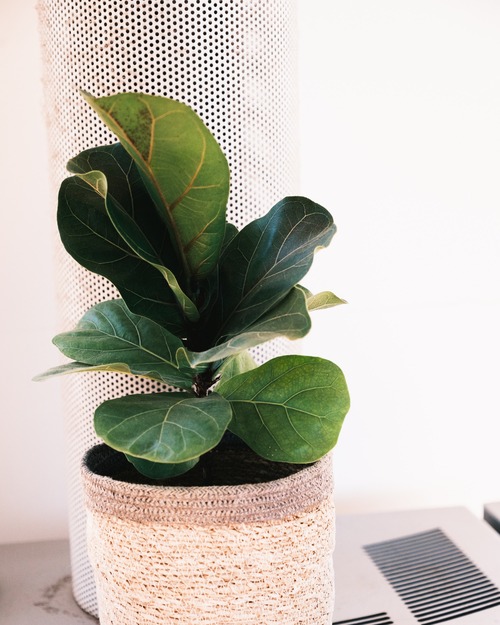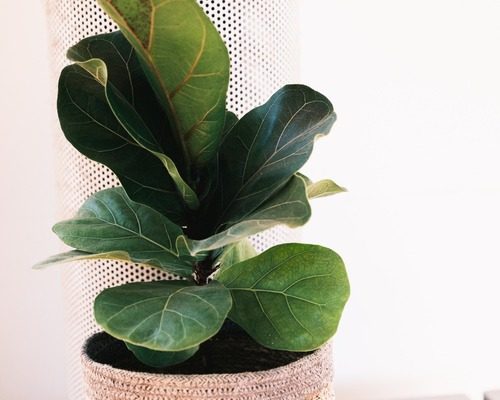Being the proud plant parent that I am, taking care of my fiddle leaf fig (Ficus lyrata) has been really fulfilling. Its big, glossy leaves have added a little bit of the elegance of nature to my house. However, I’ve faced my fair share of difficulties along the way, just like other plant lovers. One of the most baffling problems I had to deal with was an infection caused by bacteria that threatened my favourite fiddle leaf fig’s health and beauty in danger. I’ll describe what it was like coping with this bacterial threat and the efforts I took to save my favourite plant in this post.

Understanding Bacterial Infections in Fiddle Leaf Figs
Fiddle leaf figs can get bacterial infections when harmful bacteria penetrate the plant’s tissues, creating a wide range of signs that can be very distressing for any plant carer.
These signs consist of:
Leaf spots: Unusual, dark brown or black patches that form on the leaves and frequently have a wet look.
Yellowing of the leaves: Infected leaves may become yellow prior dropping off the plant.
Bacterial infections can slow the plant’s growth, leading to an apparent absence of new leaves and general vigour.
Wilting: Affected leaves may become less turgid, giving off an impression of being wilted. Foul smell: In some situations, a plant’s foul smell may be a telling signs of bacterial infestation.
My strategy for combating bacterial infection
Isolation: As soon as I became aware of the signs, I kept my sick fiddle leaf fig separate from my other plants. To stop the bacterium from spreading, this was an essential step.
Pruning: Using sterile pruning shears, I trimmed the diseased leaves. By removing the infected leaves, you are helping the plantin concentratinge its efforts on healing while reducing the bacterial load.
Surveillance and Quarantine: I kept a tight eye on my plant’s health during quarantine. This made it possible for me to monitor any new symptoms and assess the success of my initial treatment.
Improved Air Circulation: By placing the plant in a ventilated place, I was able to ensure right air flow around it. A buildup of humidity, which can worsen bacterial problems, can be minimised with adequate airflow.
Water management: I changed my watering schedule to maintain a constant moisture level without flooding the soil. Bacterial growth may be facilitated by excessive irrigation.
Sterilised Equipment: To prevent spreading more infections while pruning, I used sterilised pruning shears. Neem Oil: As a preventative step, I rubbed the plant’s foliage with neem oil, a natural and gentle fungicide. This helped discourage further bacterial development.
Recuperation and tenacity
My fiddle leaf fig started to heal over the course of time with patience and continuous attention. New leaves appeared, and the older ones turned a vivid green colour once more. It was evidence of the plant’s toughness and the success of my efforts to fight the bacterial infestation.
A fiddle leaf fig bacterial infection was challenging to handle, yet it improved my connection to my plant. It made me see the value of being alert, taking prompt action, and the incredible capacity of nature to heal when given appropriate conditions. My fiddle leaf fig is a real example of the value of dedication to taking good care of our plant friends since it is now tall and healthy
FAQ Fiddle Leaf Fig Bacterial Infections
What symptoms do fiddle leaf figs show when they are infected with bacteria?
A: The disease usually manifests as dark brown to black spots on leaves, yellowing of the leaves around those spots, an oozing slimy material, and an unpleasant stench.
In fiddle leaf figs, how do bacterial diseases spread?
A: Water is a common way for bacterial diseases to spread. Water splashing can spread germs, especially if the plant is being watered from above.
How can I keep my fiddle leaf fig from suffering bacterial infections?
A: Follow correct watering procedures, refrain from soaking the leaves, keep the area around the plant well-ventilated, and keep both the plant and its surrounds clean.
What should I do if I think my fiddle leaf fig has a bacterial infection?
A: Use sterile scissors to cut off the damaged leaves, separate the plant from other plants, and wait to water until the topsoil is completely dry.
Q5: Can a bacterial illness be cured in a fiddle leaf fig?
A: The plant can recover if the problem is identified early on and handled quickly. Serious infections, however, may weaken the plant and impede its development.
Is it possible to treat bacterial infections in fiddle leaf figs naturally?
Neem oil and diluted hydrogen peroxide are two natural remedies that some plant enthusiasts employ, but it’s important to test them on a tiny area first to see how the plant responds.
How frequently should I look for bacterial infections in my fiddle leaf fig?
A weekly inspection of your plant is a good idea. Look for any odd patches or changes on the top and bottom of the leaves.
A8: Can bacteria inflict illnesses on one plant and then transfer to another?
A: Definitely, especially if you use the same equipment or water for several plants without sterilizing them and they are near together.
Is it okay to eat fiddle leaf fig leaves that have bacterial infections?
A: Fiddle leaf fig leaves should not be eaten, whether or not they are infected with germs.
Repotting: Can it help avoid bacterial infections?
If wet or polluted soil is the source of the bacterial illness, repotting with new, well-draining soil may be helpful.

